How Long Does Prehistoric Gardens Take To See
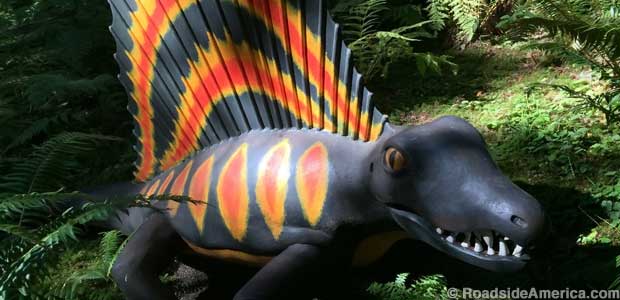
Dimetrodon at Prehistoric Gardens.
Prehistoric Gardens
![]()
Port Orford, Oregon
Classic attraction Prehistoric Gardens rewards visitors with a leap back to two fantastical eras: a rain forest from 180 million years ago in the "Age of Dinosaurs;" and a hop to the mid-20th century, when Ernie "E.V." Nelson built his dream. It's still maintained by his family today.
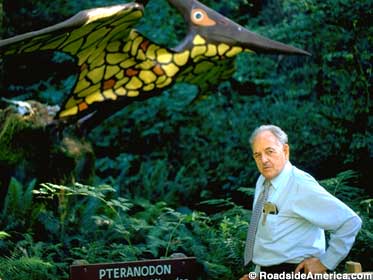
E.V. Nelson at Prehistoric Gardens (1985).
In 1953, 48-year old Nelson started creating his dinosaur theme park on land purchased along the Pacific coast, south of Port Orford. That year the region had measured ten record-breaking feet of precipitation. Nelson's property offered highway frontage and a forested slope overrun with giant ferns, drippy mosses and lichens, and ocean mist filtering sunlight through towering trees (when it wasn't raining).
An artist and science enthusiast, E.V. built enough dinosaurs to open as a tourist attraction in January of 1955. He added on until he had 23 prehistoric creatures spanning the Paleozoic and Mesozoic eras.
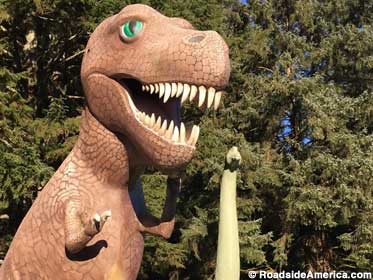
Visible from the highway: T.rex and Brachiosaurus.
We've visited dozens of American dinosaur attractions, and Prehistoric Gardens is the most atmospheric. Though it's close to the highway and not huge, visitors are quickly enveloped in the primordial, along dark, winding trails. Dinosaurs peek from sun-dappled glades or over fences. Hand painted signs provide details on each giant reptile.
Technically, if you'd visited this spot during the Mesozoic era (Triassic, Jurassic, Cretaceous periods), you'd be under the ocean, submerged along with the rest of Oregon. E.V. gives a nod to ancient water dwellers with a sculpture of an Archelon (from 700 million years ago, "the largest turtle of all time") and an Ichthyosaur ("fish-lizard"), depicted flopped helplessly on its side as it might be "during periods of low water."
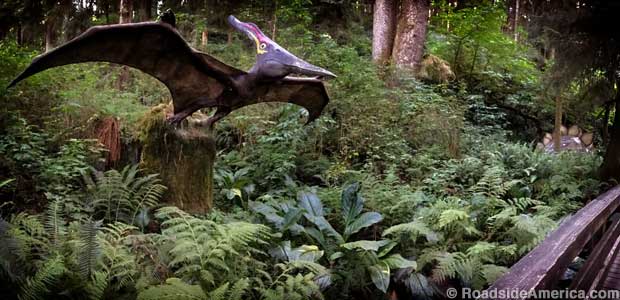
Pteranadon in 2016.
We first met E.V. on a Roadside research trip in 1985. He was cordial and funny, a regular guy -- not some nut. He led us along the trail, and talked about how he made each dinosaur -- with a metal frame, and then mesh with concrete overlay. He crafted the smaller figures in his workshop. The largest behemoths were built outside in place with scaffolding -- the 50-foot-long Tyrannosaurus, the 85-foot-long Brachiosaurus. Some took years to complete.
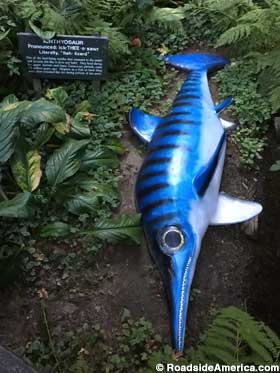
Ichthyosaur.
E.V. traveled extensively to study how the extinct giants were depicted in museums, and based his sculptures on measurements of mounted fossil skeletons. He often boasted that his life-size replicas were "scientifically correct," but his sense of color is what impressed us most. Some of his creations looked like pop-art refugees from The Land That Earth Tones Forgot, with bright slashes of yellow and orange on the Dimetrodon, or phosphorescent blue and yellow warpaint on the Stegosaurus.
E.V.'s argument: "Nobody knows what they looked like, so I can paint them any way I want."
Time has proved him correct. Not the color scheme part, but the notion that dinosaur knowledge is always incomplete. As paleontologists evolve their fossil interpretation of physical appearance, older dinosaur parks can appear outdated and cartoonish. E.V.'s garish paint patterns make his dinosaurs stylish and unique, in some way removed from the debate about which ones had feathers or dragged their tails.
E.V. died in 1999 at age 91, not far from his dinosaurs, which are now under the care of his family. His granddaughter Kiki McGrath runs the place, and plans to keep it going in the tradition of her grandfather. Some sculpture paint jobs were redone, though not enough in E.V.'s style to suit our taste. You can still marvel at the colors.
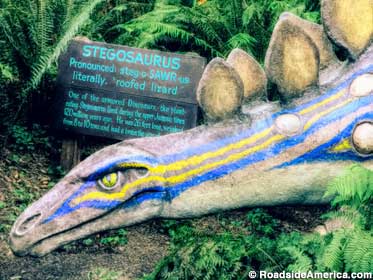
Stegosaurus.
We showed Kiki an old brochure from our files, folding out a lavishly illustrated map of Prehistoric Gardens. She said her grandfather drew the map.
With any luck, Prehistoric Gardens will preserve its unique charms, weathering fickle vacation tastes. These days the coastal highway between Gold Beach and Port Orford is not heavily traveled, with most Californians angling east towards trendy Ashland and missing P.G.'s welcoming T.rex and Brachiosaurus. There are no houses or businesses, or billboards, for miles. Its remoteness, perversely, may have helped Prehistoric Gardens survive -- as the only thing for kids to do on a long stretch of road.
In 1985, we'd asked E.V. if he had any suggestions for others who might want to build their own dinosaur attractions. His reply was, "Don't," but it was advice that he never would have taken himself.
How Long Does Prehistoric Gardens Take To See
Source: https://www.roadsideamerica.com/story/11585
Posted by: byrdboashe.blogspot.com

0 Response to "How Long Does Prehistoric Gardens Take To See"
Post a Comment